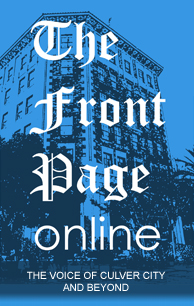A landmark day in the eighty-nine year history of Culver City, the three-person sculpting — mom, dad and daughter — will be a lasting visual tribute to a man whose accomplishments have bobbed in and out of modern-day consciousness.
Even if that is true, it is broadly agreed that Culver City residents are more actively aware of their history than persons in other Westside communities, if not Californians in general.
Julia Lugo Cerra is Culver City’s historian, a position she takes profoundly seriously. She is often the one chiefly responsible for making certain that Mr. Culver’s enormous accomplishments do not rot away in the outdoor mist or the indoor dust. She is his public relations person, and he might owe her a million dollars by now.
A member of an historic family herself, dating back to deep inside of the nineteenth century, Ms. Lugo Cerra stokes historic pride on a regular basis.
The Culver City Historical Society is more active than churches or bars are in some towns.
Members do not allow their energies to flag or the icons of Culver City history to fall into disrepair.
Motivated by Ms. Lugo Cerra, the Historical Society takes programs into the city’s schools in the form of living history. Students from Culver City High School act out scenes such as Mr. Culver’s late daughter, Pat Culver Battle, talking about her father.
Nearly everybody who has become important in the community in the years following Mr. Culver’s death in 1946 is expected to make an appearance here on Sunday afternoon.
The Battle Hymn of This Republic
More importantly, perhaps, Mr. Culver’s grandson, Dr. John Battle, his wife and their four adult children will form the centerpiece of the celebration, no matter how significant other dignitaries may think they are.
Dr. Battle, a minister in Washington state, will deliver the defining speech of Mr. Culver’s life, his vision of a community on these grounds.
Owing to the brisk pace that the Historical Society maintains across Culver City, the legends and truths of the pretty remarkable Mr. Culver are more familiar to some families than the names of their children’s school principals.
With a smile, Ms. Lugo Cerra says that she and Dr. Battle, the founding dad’s grandson, were only a year old in 1946 when Mr. Culver died at the age of sixty-six.
Still, she has managed to accumulate every single gem-like particle of Mr. Culver’s life, probably down to the color of bath towels he preferred in the 1920s as opposed to the 1930s.
From his early days in the bottle water business with his father, to his employment with the significant real estate baron I.M. Van Nuys, to his darker final days, Ms. Lugo Cerra knows him.
She knows him from his courtship and marriage to the actress Lillian Roberts, who lived a hundred and three years, to the Pierce Arrow he cruised around town in, to the Pacific Military Academy he founded, to the minutiae of his daily life.
Every noteworthy moment of his career has been prominently documented. From his Nebraska roots to his arrival in this neighborhood at the halfway mark of his life, from his earliest business dealings to more famous later ones, he left his footprints in every meaningful dimension of Culver City life.
The three main identifying stilts of Mr. Culver’s life, says Ms. Lugo Cerra, were that he was a visionary, he possessed a reliable inner sense of knowing what people wanted/needed, and, critically, he was a splendid listener.
He was not an outsized giant of unbelievable heroic proportions, but rather a dreamer and a driven man with the smarts and the steely-eyed focus to bring his visions to life.
He was an entrepreneur who created imagery in his mind, transcribed it to paper and transformed the paper into buildings.
Call Him a Developer
Best known for his sophisticated understanding of how to convert turn-of-the-century Southern California real estate into a giant casino, Mr. Culver’s appetite for developing the landscape still astounds modernists.
At the age of three-three in 1913, he delivered the pivotal speech of his life to the fashionable California Club in downtown Los Angeles.
On that occasion, he revealed his dream for building a new city midway to the ocean.
The land appealed to him because it was as flat as his native Nebraska and easily accessible. He sketched out a plan five miles from the ocean for a community that would benefit from ocean breezes but would be far enough away to avoid perceived disadvantages.
Forever, Mr. Culver will be thanked for bringing motion pictures to Culver City, the community’s worldwide identification from the baby moments of the twentieth century to this very weekend. It is only the slightest hyperbole to say that everything beyond that is a detail.
Destiny gave Mr. Culver a hug, a kiss and a dance card for life, starting from the day he found Thomas Ince, the early film genius, shooting around Ballona Creek. Mr. Culver invited Mr. Ince to organize his fledgling studio in the fledgling village he was organizing.
That was 1915. Today, two of the three studios that decamped here are doing a thriving business.
According to Ms. Lugo Cerra, Mr. Culver knew he wanted to build a balanced city where residents and businesses would have relatively equal muscle.
He lured what he regarded as the most desirable potential settlers to pre-Culver City. He brought them to this patch of land through imaginative contests.
On certain days, the couple with the prettiest baby was awarded one free lot, of land, a lucrative offer that sadly was abandoned well before the twenty-first century.
That Mr. Culver died after a capacious life appears true enough, but he also died after an amount of the glamour and sunshine had deserted him, too.
For a peek at Harry Culver’s vision for Culver City, in his words, click here for his 1913 speech to the California Club.
